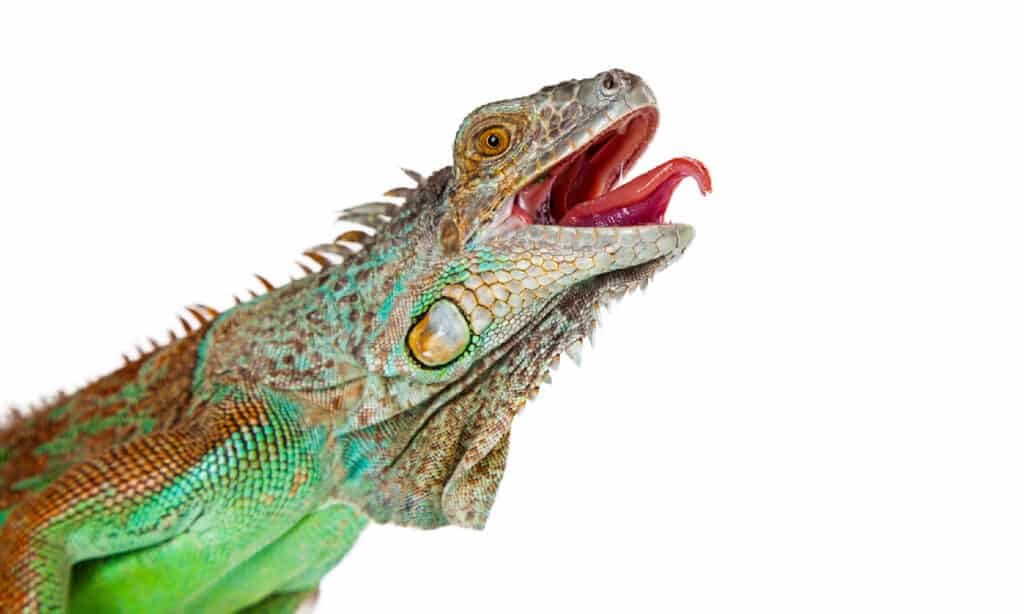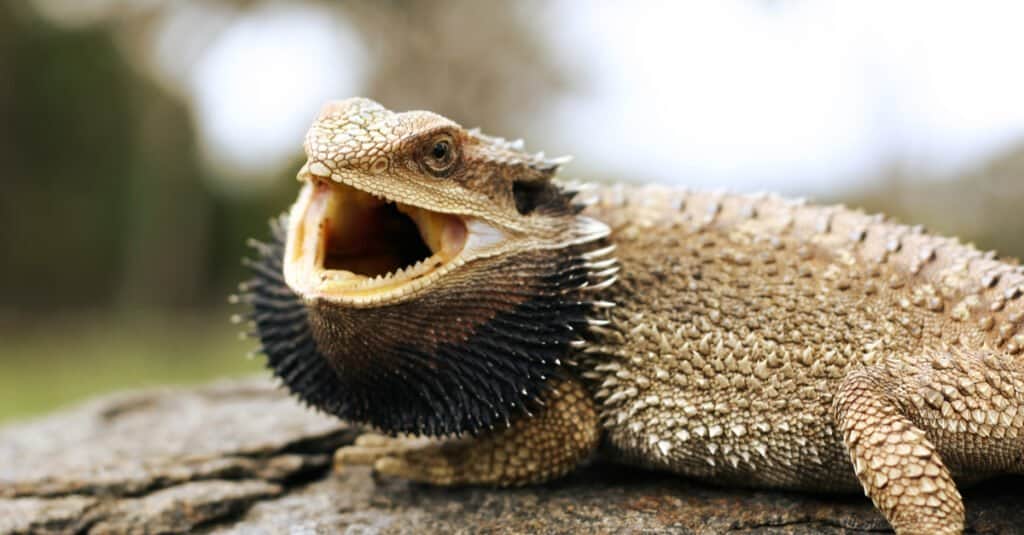
Iguanas are venomous, but this venom is harmless to humans.
©iStock.com/adogslifephoto
When provoked or threatened, biting is one of the most usual reactions done by an animal to protect themselves. If an animal is left alone it will usually not bite, but some can be aggressive and attack when threatened. Dogs and cats account for most of the bites in the U.S that require medical treatment, but what about a lizard? Do lizards bite their humans?
In most places where humans live there are also various species of lizards. Some are extremely tiny, while others can reach the size of a small dog. Biting is a common defense done by most species of lizards, but the pain of the bite will vary by species.
Most lizard bites are mostly harmless and don’t require medical treatment. Larger species have a much more painful bite, and some are even venomous. Let’s go over everything to do with lizard bites and what you should know about them.
Are Lizard Bites Dangerous?

The
leopard
gecko (Eublepharis macularius) is a cathemeral, ground-dwelling lizard naturally found in the highlands of Asia and throughout Afghanistan, to parts of northern India.
©Milan Zygmunt/Shutterstock.com
A bite from a lizard can be painful, but for the most part, it is not dangerous. Lizards will bite if threatened, and they will usually only bite when provoked. Biting is not a common way for lizards to defend themselves and only happens when you try to pick one up. Domesticated lizards can get used to being handled, and wild ones are more prone to biting.
When bitten by a lizard you may experience:
- Swelling
- Pain
- Redness
- Bleeding
Lizards have teeth that are able to puncture the skin. It is rare for a lizard to be venomous, and most bites are harmless. Larger lizards like monitor lizards are much more dangerous. They can cause bleeding and have teeth designed to tear chunks of meat off prey.
Small lizards that you will normally come across are not dangerous. These species usually only eat small insects, so their mouths do not need to be powerful. A bite from most species will usually just cause mild discomfort and is not dangerous. Only certain species are venomous and are possibly dangerous when bitten.
The Most Dangerous Lizard Bites

Around 100 venomous lizard species exist.
©vladivlad/Shutterstock.com
The Gila monster is a species capable of delivering an extremely painful bite. Gila Monsters are among the only venomous species of lizard found in North America, along with the beaded lizard. These lizards have teeth that deliver venom through chewing. When biting they will create a grip, increasing the chance that venom will be distributed.
Monitor lizards are also a venomous type of lizard. All monitor lizards are venomous which is contained in their saliva that will infect their prey, slowly killing them. Monitor lizards are some of the largest lizards in the world and will have a stronger bite when compared with other species. They have sharp teeth used for ripping through flesh and can be dangerous if bitten.
A bite from a venomous lizard like the Gila monster or monitor lizard is more dangerous. Some species like the Iguana are venomous but only have mild venom. Here are some of the symptoms when bitten by a venomous lizard:
- Vomiting
- rapid heart rate
- Change in blood pressure
- Dizziness
- Burning pain
- Swelling
Bites from these species are usually avoidable since they will only bite when handled. Gila monsters live in the deserts of Arizona and Mexico, with a small presence in other states. When not provoked they will usually not attack. A bite from a venomous species can be painful, but it is rare if it is ever deadly.
Just remember that the larger a lizard, the more attention is needed for their bites. While an iguana’s venom may not be harmful to humans, their bites are significant enough to cause wounds that require stitches. In addition, lizard bites can lead to bacterial infections and need to be cleaned very carefully. Let’s dive into how to treat lizard bites.
Who Do Lizards Bite Commonly?
It is seen that in most cases, it is children that have crossed paths with lizards get bitten most often. Why do lizards bite children?
- Children are naturally curious and do not understand the danger posed by wild animals
- Sometimes children might encounter a lizard in its natural environment and try to catch it
If a child is bitten by a lizard, they may show symptoms such as
- dilation of pupil
- sweating
- irritability
- high pulse rate
- the bitten area can develop red ring around it (erythema)
- coldness of skin
If you suspect that a child has been bitten, do not try to treat it and seek immediate medical attention.
Treating A Lizard Bite

To scare off predators some lizards will open their mouths and hiss.
©Cre8tive Images/Shutterstock.com
If bitten by a lizard it is generally nothing significant to worry about, but you should seek medical treatment if you are experiencing any severe symptoms. Some people may have allergic reactions from a bite, and be more susceptible to a venomous lizard’s bite.
When bitten you should clean the bite with warm water and soap. Cleaning it is all that needs to be done for most lizard bites, as it will heal on its own time. Keeping the wound clean will help prevent infection, and get rid of bacteria that are in a lizard’s mouth. Large lizards can deliver a nasty bite and may require stitches.
The crocodile monitor and other monitors have bites that can prove dangerous. Their teeth have a serrated structure that leads to a higher chance of needing medical attention for stitches and in some cases surgery. Large species like iguanas have a more painful bite and may need more treatment as well.
Other Ways A Lizard Defends Itself

Monitor Lizard
©Bugboy52.4 / Public Domain – License
Biting is just one way that a lizard will defend itself from a predator or possible threat. A small lizard does not do much damage, so other defenses can drastically increase their survival chances.
- Dropping their tail is an ability that some lizards utilize to increase their chances of survival. Dropping their tail can distract a predator, or help the lizard get away if its tail is grabbed. Losing its tail does not harm the lizard, and gives it a better chance of survival. Some species are also able to regrow their tail like it was never lost.
- Hissing is also another tactic a lizard will do to try and scare potential predators away. Hissing and puffing up their bodies will make some predators less likely to attack.
- Species like the bearded dragon will puff up their necks and chest, making more spikes stick out from their body. Lizards will usually try this tactic when they feel they are in danger, but before they are attacked they may try to scare off the enemy.
- Large lizard species like Iguanas can deliver a painful bite, but they also have large tails that can whip potential predators away. Iguanas and monitors effectively use their tails to hit enemies and keep unwanted animals at bay. While not as strong as a bite, a tail whip can be just as effective in the right circumstances.
Lizards will try to bite if needed, but sometimes there are better options that they can use to defend themselves. The bite from a venomous or large lizard can be painful, but most species are harmless.
Just remember if you have a pet lizard that the earlier you begin socializing and handling them, the less danger from bites. The more lizards are aware of your scent, presence, and touch, the less they’ll see handling as a threat. It’s best to begin training lizards on handling at a very young age as their bite is at its lowest risk.
The photo featured at the top of this post is © Hadrani Hasan/Shutterstock.com
Thank you for reading! Have some feedback for us? Contact the AZ Animals editorial team.






